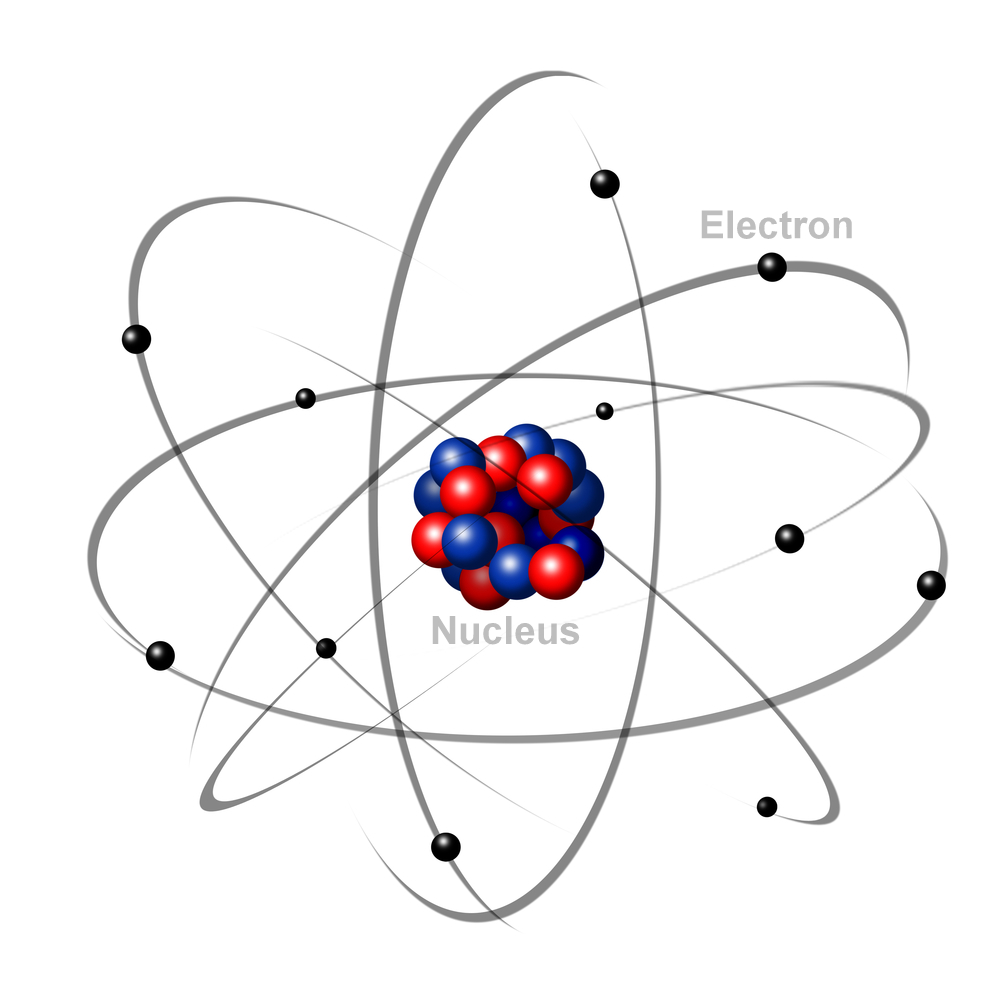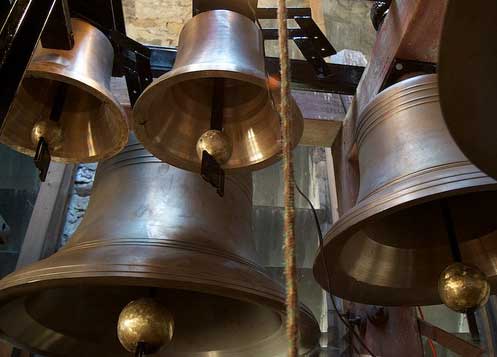Physicist: This is a bit of a misnomer.
When we picture an atom we usually picture the “Bohr model”: a nucleus made of a bunch of particles packed together (protons and neutrons) with other particles zipping around it (electrons). In this picture, if you make a guess about of the size of electrons and calculate how far they are from the nucleus, then you get that weird result about atoms being mostly empty. But that guess is surprisingly hard to make. The “classical electron radius” is an upper-limit guess based on the electron being nothing more than it’s own electric field, but it’s ultimately just a gross estimate.

The picture gives you an idea of more or less where things can be found in an atom, but does a terrible job conveying what those things are actually like.
However, electrons aren’t really particles (which is why it’s impossible to actually specify their size); they’re waves. Instead of being in a particular place, they’re kinda “smeared out”. If you ring a bell, you can say that there is a vibration in that bell but you can’t say where exactly that vibration is: it’s a wave that’s spread out all over the bell. Parts of the bell will be vibrating more, and parts may not be vibrating at all. Electrons are more like the “ringing” of the bell and less like a fly buzzing around the bell.
Just to be clear, this is a metaphor: atoms are not tiny bells. The math that describes the “quantum wave function” of electrons in atoms and the math that describes vibrations in a bell have some things in common.
So, the space in atoms isn’t empty. A more accurate thing to say is that the overwhelming majority of the matter in an atom is concentrated in the nucleus, which is tiny compared to the region where the electrons are found. However, even in the nucleus the same “problem” crops up; protons and neutrons are just “the ringing of bells” and aren’t simply particles either. The question “where exactly is this electron/proton/whatever?” isn’t merely difficult to answer, the question genuinely doesn’t have an answer. In quantum physics things tend spread out between a lot of states (in this case those different states include different positions).
The atom picture is from here.








I imagine space as a gluon field. The way gluons structurally bind to form exclusion patterns means that just like you can find bubbles in water you can also find structures in gluons. Just like quarks are structures in gluons supported by the way gluons transit states and those states changes propagate. At the macroscopic level of human observation this gives rise to the temporal and spacial sense that has served the mammalian predictive survival model very well.
In the Bohr billiard ball model, the red proton “ball” is really a collection of three stable gluon patterns in a sea of busily state transitioning gluons. There is no empty space, and space like time is just an illusion.
The ringing of a bell analogy still leaves us far from a connection to the reality of what matter, particles and space are as constituents of an atom. The ringing of a bell rings the bell. What does the “ringing” of an electron or proton ring, space, or the electromagnetic field?
Then when you consider larger entities it gets less intuitive. Particles can be thought of as stacking up into something bigger, like the peg and ball models chemists use, but resonances of indeterminate size ringing nothing somehow dance together to form all that we experience. That is a great conceptual void.
Doesn’t the wave-particle duality say that there’s still a discrete physical entity? It’s the probability distribution that’s smeared out, and observing the particle collapses that probability (since it’s now certain where exactly it is), right?
I didn’t think the electron itself was smeared out. If it isn’t, I think a better analogy would be a beach ball in a pool. The difference of course is that that electrons have velocity, whereas the ball is entirely at the mercy of the waves. So ok, maybe an even better analogy would be a toy motorboat in a pool, propelling itself forward, yet having a less predictable position over time.
Interesting post!
@Joe
This is really subtle, and complicated enough that it would have totally derailed the post. It turns out that things being in multiple states (and positions) is fundamental. You literally can’t describe the universe in terms of things being in definite places and states (without making up a lot of weird ad hoc laws). There’s an old post here that talks about how we can know something so deeply bizarre.
So what happens to those electrons (their smearyness, or definite position-ness or lack there of) if we stop their motion? Say hypothetically drop the atom to absolute 0 K?
Since all matter is just compressed energy, everything would be a wave and the particle would be nothing more than a very high energy portion of the wave.
Here’s something to consider. According to quantum physics, the “empty space” here should really be filled with virtual particles, which basically appear and disappear within a very short amount of time. As far as I understand, this arises from the fundamental uncertainty of the amount of energy (interchangeable with matter) in a field. I am not a formally trained physicist, so if anyone can explain this better or correct any error I made, feel free.
If there are dark energy and dark mass, there is no such thing as “Einsteinan vacuum”, i.e. a space whereas all values of fields are zero. So, consequently, with time, the dark energy will “dissolve” even atoms in to a Big Freeze. At least this is today’s theory, as far as I understand it.
Wouldn’t it be more honest to say that we don’t have the math, technology or the conceptual fortitude to accurately explain the position of all sub atomic particles? Rather than saying ‘its a smearing’? Doesn’t the Heisenberg Uncertainty principle codify our inability to fully explain the world of quantum mechanics?
Not sure if it is a normal space. But In my opinion it must be some exotic kind of space, we never experience in real life.
the electron “cloud ” fills much of this “empty” space……..
Why are atoms built, shaped like they are? One of the more general things about particle distribution in atoms is that they are shaped like an ongoing perpetual explosion… the heavy stuff in the middle (protons, neutrons) and the light fluffy stuff (electrons) thrown to the outside. Maybe, maybe not.
I used this simple principle in developing a more elaborate idea I once had to improve my understanding of Einstein’s relativites and cosmology. As a bonus, it seems to help explain the logic behind the weird “spacey dust-cloud” blueprint as well. Afterall, a universe inhabited by simple little square solid-block atoms would be much more aesthetic, if it were up to me.
Amaven said: “Wouldn’t it be more honest to say that we don’t have the math, technology or the conceptual fortitude to accurately explain the position of all sub atomic particles?…”
I agree. After all, modern science is barely three hundred years old, so we cant expect to know all of the answers – or indeed even most of the answers – about the subtle levels of nature’s functioning. To quote …
“Everything, however complicated – breaking waves, migrating birds, and tropical forests – is made of atoms and obeys the equations of quantum physics. But even if those equations could be solved, they wouldn’t offer the enlightenment that scientists seek. Each science has its own autonomous concepts and laws”.
-Martin Rees
The atom has some extension. Looking at the electron as a wave rather than its character as a particle smears it out so it has extension even if the boundaries cannot be specified. This wave extends into what space within the atom to give us what is considered the size of any atom? Apart from the waviness of the electron (is that an electromagnetic waviness?) is there anything other defining the space inside the what is understood to be the volume of an atom?
It is curious that with all the uncertainty about electrons we have the certainty to build multitudes of devices in which we use electrons with finesse.
@Anaven:
That’s not really what the Uncertainty Principle by Heisenberg states.
@Anaven
Uncertainty is a fundamental part of our universe. Any attempts to come up with hidden variables lead to theories that predict information already known but nothing new.
Void is like lack of imagination the head of your dearest moderator(s) who were so kind to erase the correct answer and let established crap rule this forum. This is how people were kept in the dark when they thought that the earth was flat. There were enough people who knew better but they needed to be kept quiet not to embarrass all those geniuses that kept crap the only voice.
I say, space is a black place above earth and to its sides and under it that has stars (suns). Lol thats what public schools teach, I think space is a made up place. Lol jk its hard to explain
Physicist said in 2015;
When we picture an atom we usually picture the “Bohr model”: a nucleus made of a bunch of particles packed together (protons and neutrons) with ……..
Just for the records that we pictured almost everything wrong, I have to ask this question,
If you look at the above image of the Bohr model, you see a drawing for the atom with electrons rotating around (protons and neutrons), right?
Now, we think we’re talking about an iron atom. Do you want to tell me that the bridge of San Francisco is holding itself with (rotating electrons around atoms)? electrons that they do not and never collide? or how do these atoms hold together when electrons rotate or when there is a large space between them?
How we can drive safe on that bridge then?
Do you know what, I think Bohr model is totally wrong.
Jimmy
The physicists answer described the electron as a field. This is a bright day in this dark world of particles..,,Douglas Ralph Belfry
Could the simple answer to the question be no it is not a vacuum. It is an energy field consisting of energy and sub atomic particles that pop into and out of existence on a continuous basis.
the question is unclear. at moment x, an atom has a location in spacetime, at moment x+1, it has a different location in spacetime. the “space” between a proton and an electron at moment x is one chunk of spacetime and at moment x+1, it is a different chunk of spacetime as the atom will certainly have moved on SOME frame of reference, macro or micro. So you presumably are following through time a space between a moving proton and a moving electron and asking about that space in between them. What could you be asking about that space when you ask its characteristics other than ‘how does that particular slice of space (as it moves through time) interact with other forces or particles?’ Does it permit other things to pass through that space? Neutrinos? Probably, mostly yes. Electrons or protons? Probably mostly no. Neutrons? Probably somewhat although an electron collision would be probable, whatever that meant? Would gravity have an effect on the space between the proton and electron? certainly, yes it would affect the topology of the entire system. What else is the thought-question asking?
If matter is just a slower form of energy then the universe is full and so would the vacuum of space be full. You would have solids, liquid, gas, plasma, and energy at various energy levels all through the universe.